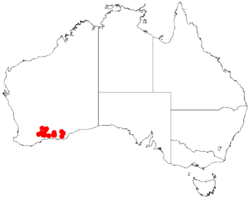Biology:Acacia nivea
| Acacia nivea | |
|---|---|
| Scientific classification | |
| Kingdom: | Plantae |
| Clade: | Tracheophytes |
| Clade: | Angiosperms |
| Clade: | Eudicots |
| Clade: | Rosids |
| Order: | Fabales |
| Family: | Fabaceae |
| Subfamily: | Caesalpinioideae |
| Clade: | Mimosoid clade |
| Genus: | Acacia |
| Species: | A. nivea
|
| Binomial name | |
| Acacia nivea R.S.Cowan & Maslin
| |

| |
| Occurrence data from AVH | |
Acacia nivea is a shrub of the genus Acacia and the subgenus Plurinerves that is endemic to south western Australia .
Description
The low spreading shrub typically grows to a height of 0.4 to 1 metre (1 to 3 ft) and has a dense and domed habit with terete, hairy and resinous branchlets. Like most species of Acacia it has phyllodes rather than true leaves. The glabrous, resinous and evergreen phyllodes are inclined to erect and straight to curves with a length of 1 to 2 cm (0.39 to 0.79 in) and a diameter of 0.8 to 1.2 mm (0.031 to 0.047 in) and have 12 to 16 slightly raised fine nerves.[1] It blooms from July to September and produces yellow flowers.[2] The simple inflorescences are found in pairs located in the axils and have spherical flower-heads with a diameter of 2.5 to 3 mm (0.098 to 0.118 in) containing 9 to 12 golden coloured flowers. The thinly leathery to chartaceous seed pods that form after flowering have a linear to slightly curved shape and are raised over each of the seeds on alternate sides. The pods have a length of 3 to 3.5 cm (1.2 to 1.4 in) and a width of 3 mm (0.12 in) and contain longitudinally arranged seeds inside.[1]
Taxonomy
It belongs to the Acacia dielsii group.[1]
Distribution
It is native to an area in the southern Wheatbelt and Goldfields-Esperance regions of Western Australia where it is commonly situated on undulating plains growing in clay-sand or sandy-loam or sandy soils.[2] It has a scattered and discontinuous distribution from around Lake King in the north west to around Munglinup in the south west with populations extending out to Grass Patch and the Mount Andrew and Ponier Rock in the east usually as a part of low open shrubland or tall mallee shrubland and low open woodland communities.[1]
See also
References
- ↑ Jump up to: 1.0 1.1 1.2 1.3 "Acacia nivea R.S.Cowan & Maslin". Wattle - Acacias of Australia. Lucid Central. https://apps.lucidcentral.org/wattle/text/entities/acacia_nivea.htm. Retrieved 20 December 2020.
- ↑ Jump up to: 2.0 2.1 "Acacia nivea". FloraBase. Western Australian Government Department of Parks and Wildlife. https://florabase.dpaw.wa.gov.au/browse/profile/16136.
Wikidata ☰ Q9567415 entry
 |

